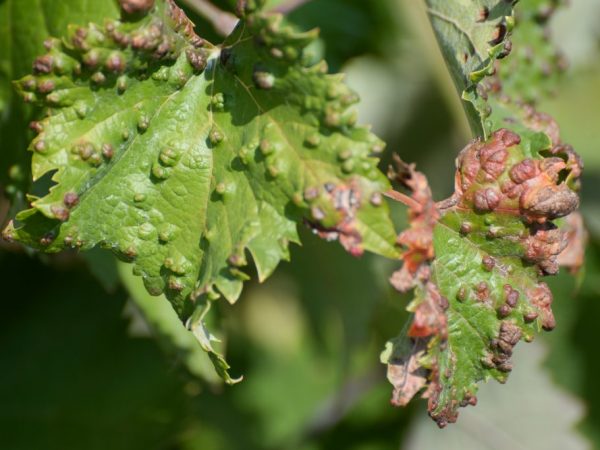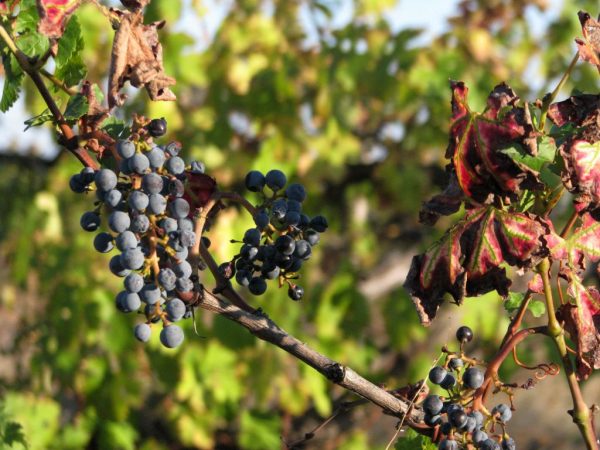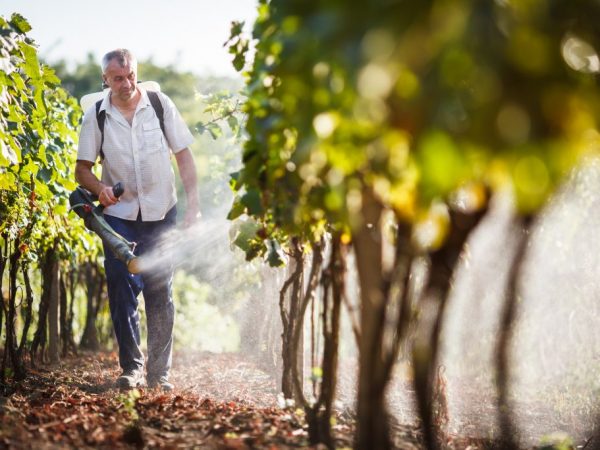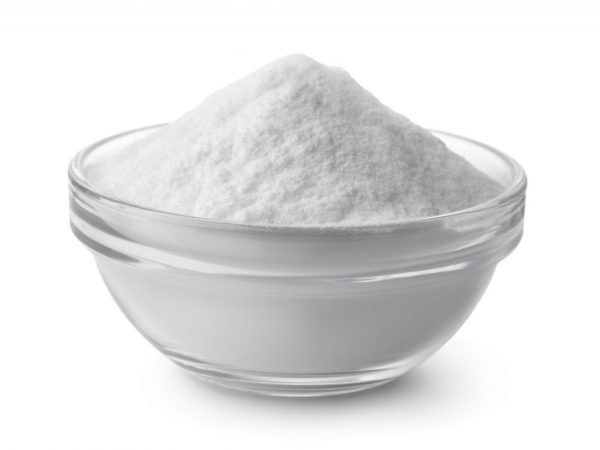Treatment of grape leaf diseases
Diseases of the leaves of grapes disrupt its vital functions and lead to a decrease or lack of harvest.

Treatment of grape leaf diseases
Description of diseases
Grapes suffer from viral and fungal diseases.
Anthracnose
Anthracnose is a fungal disease that predominantly affects young grapes. This happens in the spring and summer. Its causative agent is Gloeosporium ampelophagum Sacc. It is widespread in Europe, Asia, America, Australia. Reaches the greatest distribution in a warm humid climate in Central Asia, Transcaucasia, the subtropical climate of the Caucasus, Ukraine, Moldova. The main reason for the development of the disease is soil acidity, lack of potassium and phosphorus.
The pathogen is able to tolerate frosts in grape leaves spoiled by it. It remains inactive for up to 5 years in the form of mycelium with spores. Under favorable conditions, it produces 5 cycles of spores per season.
Mild to severe signs of illness:
- the formation of brown, red spots of irregular shape on leaves with a light border around the edges;
- dying off of tissues inside the spots, the formation of holes in parts of the bush that turn red;
- the appearance of depressed points on the leaf petioles, which are covered with brown, pink, gray bloom, rust;
- cracking of the petioles;
- rolling leaves;
- dark brown staining of most of the plant;
- loss of up to 70% of leaves.
Mildew
Downy mildew, or mildew, is the most harmful to plants. It is caused by the pathogen Plasmopara viticola Berl. et Toni. The disease was brought to Europe from America. Distributed in Eastern Europe. The disease loves young grapes, humid temperate weather, cool summers with frequent rains, and mild winters. It actively develops at a temperature of 20 ° C-25 ". During the season, the disease displays 16 generations of spores.
The first sign of the disease is the appearance of an oily spot on young leaves. Then a powdery coating of a pinkish-white hue forms under it, which provokes the curling of the leaves. As a result, grape leaves turn red, curl, dry. With a severe degree, curliness appears on them.
Powdery mildew
Powdery mildew is spread by the fungus Uncinula necator Burril, which came to Europe from North America.
The main symptom of the disease is considered a lag in leaf growth. They darken, dry out, curl, become covered on the outside and inside with a white-gray bloom, and become full of holes. A plaque of spores appears on and around the holes.
After infection, the fungus adapts to the new environment in 1-2 weeks, spores and mycelium appear. The pathogen is distinguished by its ability to multiply at low humidity and temperatures from 5 ° C. The fungus quickly infects plants with poor ventilation of the room, dense foliage of the culture.
Gray rot
The causative agent of gray rot botrytis settles on young leaves. It forms a gray dusty coating of spores at the edges.Prefers dense plantings in cold rainy spring.
At the first stage, the leaves of the grapes curl up in a tube. The neglected stage is characterized by wrinkling of greenery, tissue death. In dry weather, sick twisted leaves wither, the berries dry out, become covered with pimples.
Black spot

The disease can spread to berries
The causative agent of black spot is the highest fungus from Deuteromycetes. At the first stage, with an air humidity of 85% or more, pests penetrate the wounds with mechanical damage on the leaves, where they form round or oval black grains - pycnidia. They come out at temperatures from 8 ° C. In wet weather, they are spread by drops of water, and in drought they are spread by insects and wind.
The body of the fungus forms a rotten brown area, in which berries are also involved. Later they dry up and grow. Food stops in the plots. Necrosis is surrounded by a light brown border in a hole.
Viral diseases
Among viral diseases, the most dangerous are: yellow mosaic, or infectious chlorosis, short knot, bordering veins. The cause of the disease is short-node viruses, which manifests itself in the spring as yellowing, twisting, rust of grape leaves. Shoots dry, curl up, berries fall off, flowers wither, grape leaves slow down growth, since the vascular system is affected. Pests become active in wet, cool weather. With the onset of a persistent high temperature, the development of diseases is suspended.
Chemicals
In case of fungal diseases in early spring, the plant begins to heal when the length of their shoots is no more than 10 cm. The grapes are processed from top to bottom in the evening. The reason for this is to protect the plant from sunburn. Leaves should not be wet. If it rains immediately after treatment with fungicides, they are reapplied.
The grapes are sprayed with a fine spray bottle. Such drops linger, do not roll down, falling on the inner side of the sheet. The container is filled with a chemical.
When treating fungal diseases, it is taken into account that repeated use of one fungicide increases the resistance of fungi to it by 3-5 times.
Safety measures when working with fungicides:
- put on gloves, respirator;
- dilute substances in the open air;
- avoid contact with eyes, skin;
- do not eat or smoke during the process;
- wash hands after work.
In case of contact with skin, mucous membranes, rinse them thoroughly with running water. If swallowed, drink 2-3 tbsp. water with activated charcoal, induce vomiting, consult a doctor.
Fundazol
Fundazole is a systemic contact agent in the form of a white powder. Its active ingredient is benomyl. Its concentration in the preparation reaches 50%. It is insoluble in water and other liquids. Has a faint odor, but irritates the mucous membrane of a person. The drug is highly toxic, has a hazard class 2. It causes dermatitis when it comes into contact with exposed skin. The solution is sucked into the leaf by contact when spraying, without passing into other green parts. The systemic effect is manifested when applied to the soil, watering. The substance moves upward from the roots along the vascular system.

The number of treatments depends on the stage of the disease
The effectiveness is due to the violation of cell division of the fungus. The medicine is used before flowering as follows: the powder is diluted with water in a ratio of 1:10, sprayed onto the leaves, and introduced into the soil.
The first 3 days, the drug heals the plant. The next week - protects against re-infection. The substance does not inhibit the growth of the culture when applied in the amount recommended on the package. It is not used simultaneously with acidic, alkaline agents. The number of treatments depends on the disease:
- black spot - 4;
- powdery mildew - 3;
- gray rot - 2.
Previkur
Previkur is a broad systemic liquid fungicide with active ingredients: propamocarb 530 g / l, fosetyl 310 g / l.Human toxicity class - 3, moderately toxic.
Treatment is based on blocking cell membranes, which leads to a stop of the growth of mycelium, spores within 24 hours. Then for 1-2 weeks the fungicide performs a protective function.
The substance moves through the roots through the plant, has an indirect effect on the culture's immunity, which prevents bacterial infection. It helps with downy mildew, gray mold. The substance is diluted in a plastic container, not in a metal container, since it corrodes the metal. The green parts of the plant are moistened with this solution at a concentration of 5 ml per 1 liter of water for 1.5-2 weeks. The soil is watered at the rate of 3 ml / 2 l of water.
The product is recommended to be mixed with contact fungicides. Complex action increases efficiency.
Ordan
The drug has contact, systemic, local activity. It is compatible with fungicides other than alkaline ones. The composition of the powder moderately dangerous for humans (class 3) includes: copper oxychloride - 690 g / kg, cymoxanil - 42 g / kg. The compounds inhibit the growth and reproduction of fungal cells.
Stir 25 g of powder in a little water until dissolved. Then the liquid is poured into 8-10 liters of water, stirred. For the treatment of anthracnose, downy mildew during the growing season, this agent is used for 3 treatments per season with an interval of 14 days. The mixture is sprayed, the leaves are wiped with it, and introduced into the soil.
Arcerid
A chemical 60% preparation in the form of a powder of light brown color Arcerid belongs to fast-acting fungicides (1-3 hours), contains metalaxyl, polycarbacin. Systemically, contact through stems and leaves affects pathogens, inhibits growth, breaks intercellular connections.
Consumption rate in the treatment of anthracnose, black spot, powdery mildew, downy mildew - 35-40 g / 10 l of water 4 times with a break of 20-25 days. During this period, the substance protects the culture from new infection.
Among the advantages are water resistance, preventive properties, protection during storage. It accumulates in the body weakly, in the recommended doses it is not capable of causing human poisoning (hazard class 3).
Folk remedies

Soda will help fight powdery mildew
Folk remedies are effective in the early stages of disease development, when the bushes are not yet completely covered with pathogen spores.
Fungal diseases cannot tolerate an alkaline environment, therefore, the treatment is based on alkali. The baking soda methods are effective for powdery mildew and downy mildew. Mix 25 g of soda ash with 5 liters of hot water. The solution is cooled. The plant and the topsoil are washed with this tool once a week. 3 procedures are carried out.
4 liters of water are mixed with 0.5 tbsp. l. liquid soap and 1 tbsp. l. baking soda. The solution is used every week for a month.
For the treatment of mildew, a remedy is prepared from potassium permanganate. 2.5 g of the substance is mixed with a bucket of water. The plant is sprayed 2 times a week for 2 months.
Black spot is removed with serum. The concentration of the product with water is 1:10. Irrigation of the plant prevents the contact of mycelium, spores with air. The fungus dies, and the grapes heal: the leaves no longer spin, they are saturated with useful substances. The tool is used 3 times every 3 days.
Gray rot is killed by a decoction of horsetail. Cooking steps:
- the grass is poured with 1 liter of cool water;
- in a day, the agent is boiled;
- the resulting strong broth is filtered, cooled;
- the concentrate is diluted with water 1: 4.
Effective 4-time treatment within 4-5 days. Each time a new substance is prepared.
Rot can be treated with ash and soap. 1 kg of the substance is poured into a bucket of warm water, insisted for 5-7 days. Then the liquid is filtered, 1 tbsp is added. l. liquid soap. The solution is poured under the root, they are sprayed with the inside of the leaves every day for a week.
Potassium iodide liquid helps to get rid of external local manifestations of rot.It is diluted with water in a ratio of 1: 5, after which it is applied pointwise to the lesions.
Copper sulfate treatment is successfully used for any fungal infections. 5 g of copper are diluted with 300 g of hot water. The vitriol solution is slowly poured into a 5-liter container full of water with 50 ml of liquid soap. Mix the liquid thoroughly. Spraying is carried out 3-4 times with a break of 10 days.
Rotten manure, mixed with water in a ratio of 1: 3, infused for 2 days in a cool dry place, helps against anthracnose. The product is suitable when diluted 1: 1 with water.
A solution of garlic against fungal diseases is prepared as follows: 25 g of the product is mixed with 1 liter of boiling water, left for 1 day. After a lapse of time, the agent is filtered. It is used for any fungal plaque on the leaves.
Prophylaxis
An effective preventive method for countering fungal diseases is the cultivation of varieties resistant to them. Golden firm and Pineapple grapes are not affected by mildew. Dniester pink opposes powdery mildew, black spot. Buffalo is resistant to gray mold, mildew.
Fungal immunity does not mean lack of grooming. To reduce the likelihood of a disease, the plant is sprayed with copper oxychloride, cuproxate, oxychom.
The infection is transmitted through inventory, water. Pests contribute to its spread. Tools must be disinfected after use. Regular inspection for the presence of pests, timely disposal of them improves the resistance of the grapes. The soil for the culture is disinfected, calcined.
Preventive agronomic measures:
- improving air circulation by thinning plantings;
- regular digging of the soil;
- correct pruning, fragment of shoots;
- timely tying;
- weed removal;
- spraying with 1% Bordeaux liquid before flowering;
- rubbing with potassium permanganate of the green part of the plantings.
Conclusion
Fungal diseases of grapes are difficult to eliminate. Fighting viral diseases of grapes follows the only effective method: sanitary selection. It is designed to create seedlings without viral strains. The diseased bush is destroyed in order to avoid contamination of other plantings.


